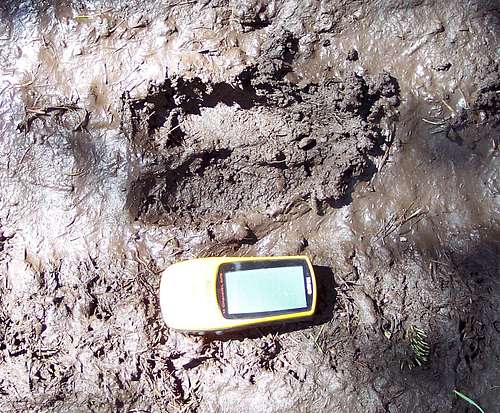Layout designed for best viewing on a "1024 x 768" screen.
![Kootenai Peak and Moose]() Moose habitat, saintgrizzly photo.
Moose habitat, saintgrizzly photo.![bighorn bull]() Shiras Bull Moose, jharrwyo photo.
Shiras Bull Moose, jharrwyo photo.Introduction:
Shiras Moose are the largest mammals of the Rocky Mountains. Many people underestimate moose and take too many risks while attempting to get the great photo. An encounter with a cow moose and her calf can have dire results. When you encounter moose keep in mind this is a wild animal and it is extremely unpredictable. Do not invade its safety zone and use your telephoto lens to get that great close-up from a safe distance!
Although moose are not typically found in the high country they frequently are seen on approaches to the summits. Keep your eyes open and you just might see this incredible Rocky Mountain Mammal.
Please attach your quality Shiras Moose photos!
![Bull Moose Guarding Pregnant Cow]() Authur Digbee photo Authur Digbee photo |
![Extreme Caution!—Mother and Calf]() saintgrizzly photo saintgrizzly photo |
![Moose galore.]() Dean photo Dean photo |
Shiras Moose, Alces alces shirasi:
Common Name: Yellowstone moose, Wyoming moose
Shiras moose are the smallest of the subspecies of moose. A Shiras bull will weigh up to 1,000 pounds, while standing 5'6" to 5'9" at the shoulder. It carries a rack that spreads from 40 to 50 inches wide. The Shiras is much lighter in color along its back compared to other species of moose. Interestingly enough the moose’s face changes from a light brown color in summer and becomes darker in color as breeding season approaches. The legs are lighter in color than the body. Both bulls and cows have a "bell" which is the flap of skin and long hair that hangs from the throat.
Moose will eat about 50 pounds of food a day. Moose feed on leaves, twigs, bark and buds of trees and shrubs. In the summer moose feed heavily on aquatic plants and can often be found with their head under water eating something off the bottom of a pond.
Life Cycle:
![Mother and Child]() Cow and calf, Mountain Jim photo.
Cow and calf, Mountain Jim photo.
The moose rut or breeding season begins in the early fall around the end of September and into the first part of October.
Bulls will duel other males for the permission to breed the cow. Bull moose are frequently seen scraping their antlers on trees, creating muddy holes called “wallows” to roll in. They do not focus on anything except breeding and can loose a large amount of body weight during the rut. Moose become more aggressive than usual and may charge at people and cars. Breeding occurs from mid-September through mid-October. Cow moose attract males with both calls and the scent of estrous. If you hear a strange sound that
Cows come into maturity when they are one and a half years old. They carry their calf for about 230 days before giving birth. Most calves are born near the end of May. Usually a single calf is born but sometimes in good conditions twins might be born. The calf weighs about 30 pounds and has a reddish-brown coat. The calf will stays with its mother until the next calf is born.
To hear a moose call please link to this site
Moose Call and listen to the on Moose Calls #1-8. The other numbers 9 & 10 are actually Bull elk bugling.
Distribution:
Shiras moose are found in western Wyoming, western Montana, northern and central Idaho, southwestern Alberta, southeastern British Columbia, and in isolated areas of Utah, Colorado, and extreme northwestern Washington
Moose can be found in a wide variety of habitat. I have seen them in the lowlands standing in water eating plants and also seen them up high near the tree line during the fall.
Natural Predators:
Healthy adult moose have few natural enemies. Calves are always at risk from predators, such a black bears, grizzly bears wolves and mountain lions. However the predator must first get past the always protective mother.
Moose have a nasty reputation of being very aggressive and much of this is well deserved. I have heard of stories about moose attach road maintenance machines. More people are killed by moose than by bears and this may be a result of misperception of the moose’s demeanor and their “safe space” is invaded and they attack to defend themselves or their young.
Threats from Mankind:
![Moose track]() Moose track
Moose track
The largest threat to the Shiras Moose is the loss of habitat.
Other threats from the past, such as overhunting, have effectively been addressed by state wildlife management entities. For example, Shiras moose occurred in low numbers in Idaho throughout the 19th century. From 1899 to 1945 they were fully protected in Idaho. The moose populations increased during the 20th century and harvest seasons resumed in 1946. Current harvest focuses on mature males, allowing continued population growth. The plan worked so well that by 1980 moose were moving out of their home range and moves south ward from Northern Idaho.
Conservation:
At this time the main focus is developing large areas of land called conservation easements. Conservation easements permanently protect private lands in the United States which ensure healthy secure habitat for all animals.
State wildlife mamangement agencies are also managing the species by selective harvest practices.
The Future:
At this time the population of Shiras moose appears to be stable. Continued conservation will certainly benefit this incredible species of Rocky Mountain Mammal.












Comments
Post a Comment